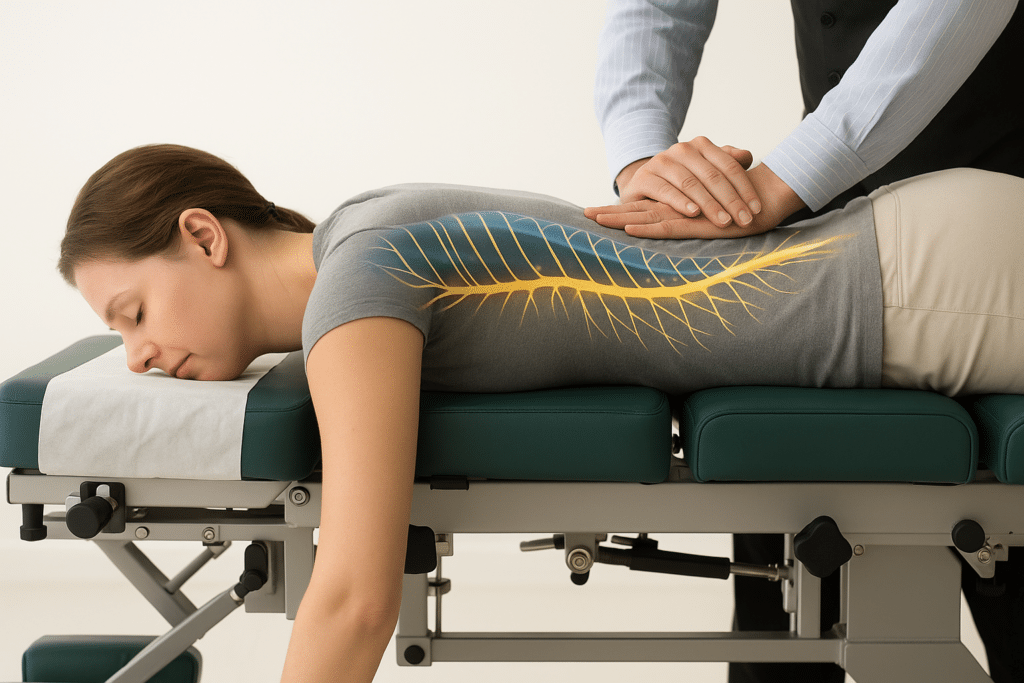Answered: Does A Chiropractic Adjustment Hurt?

Table of Contents
Are you dealing with back or neck pain? You’re not alone. Chiropractic adjustments are a popular solution designed to ease discomfort and improve mobility. This article will explore whether these adjustments hurt, offering insights and tips to ensure comfort.
Key Takeaways
- Chiropractic adjustments may cause quick pressure, popping sounds, muscle relaxation, mild discomfort, warmth in the adjusted area, or movement during the session.
- Feeling sore after an adjustment is common and often feels like exercise-induced soreness. It usually goes away within one to two days.
- Drinking water, staying gently active, following your chiropractor’s advice, applying ice or heat as recommended, resting when needed, considering gentle massage therapy, getting enough sleep, and eating healthily can all help reduce discomfort after an adjustment.

Understanding a Chiropractic Adjustment
A chiropractic adjustment involves a licensed chiropractor applying precise, targeted movements to the spine’s vertebrae. This process aims to correct misalignments—known as subluxations—that can cause pain and dysfunction in the body.
Adjustments help restore proper alignment and improve physical health, focusing on relieving symptoms like back pain, neck discomfort, and headaches. The technique employs hands or specialized tools for spinal manipulation to enhance spinal motion and overall physical function.
Chiropractic adjustments are much more than just a quick fix; they’re about restoring your body’s natural balance and function,” explains Dr. Evan Norum, a seasoned chiropractor in New Berlin, WI.
During an adjustment, you might hear cracks and pops—gas bubbles releasing from your joints. This is normal and part of relieving pressure in your muscles and joints.
Chiropractors tailor each treatment plan to fit individual needs, ensuring the safe application of high velocity and low amplitude thrusts necessary for effective adjustments.
Does a Chiropractic Adjustment Cause Pain?
Many wonder if a trip to the chiropractor brings pain. The truth is, while some feel immediate relief, others may experience slight discomfort.
Patients often describe the sensation of an adjustment as a sudden relief. The sounds you hear, much like the pop of opening a champagne bottle, signify the release of pressure and are completely normal,” Dr. Zach Bruley says.
Familiar sensations during an adjustment
A chiropractic adjustment can lead to various sensations. These feelings are typically brief and indicate your body’s response to the treatment.
- A quick sense of pressure happens when the chiropractor applies a firm, quick force to adjust the spine or joints.
- Popping sounds: Don’t worry—this noise comes from releasing gas bubbles in your joints, similar to when you crack your knuckles.
- Muscle relaxation: After an adjustment, you might feel your muscles releasing tension, leading to a sense of ease and comfort.
- Mild discomfort: Some patients report a slight discomfort during the adjustment, but it usually passes quickly.
- Warmth in the area adjusted: Increased blood flow can make the treated area feel warm for a short time.
- The feeling of movement: You might sense a shift as parts of your body realign. It’s a sign that things are adjusting towards their proper place.
Post-adjustment soreness
Feeling sore after a chiropractic treatment is common. Your body is adjusting to its new posture, which can lead to minor aches in the muscles or spinal joints. This discomfort often mirrors the soreness felt after exercising and usually fades within one or two days.
Feeling some soreness after an adjustment is akin to the discomfort you might feel after starting a new exercise routine. It’s a sign that your body is adapting and healing,” notes Dr. Taylor Moore.
Some patients might notice headaches, fatigue, or even slight pain after adjustment. These signs are part of the body’s natural response as it adapts to movements during the session.
While muscle adaptation involves lengthening or shortening slightly, it’s essential for healing and achieving greater mobility without pain from conditions like sciatica or low back pain.
Remember, experiencing these sensations signals that your body is working toward better health.

How to Minimize Discomfort After an Adjustment
New patients often wonder about discomfort after chiropractic adjustments. Here’s how to minimize any soreness you might feel.
- Drink plenty of water. Proper hydration keeps your body functioning well and helps reduce post-adjustment soreness.
- Stay active, but don’t overdo it. Gentle movements can keep your muscles loose without adding strain.
- Follow the practitioner’s advice. They know your body’s needs and can recommend the best activities post-adjustment.
- Apply ice or heat as suggested. This can ease muscle tension in the neck or back area, relieving pain.
- Rest if you need to. Sometimes, your body needs a break to heal correctly, especially after spinal adjustments or neck manipulation.
- Consider gentle massage therapies. These can help loosen tight muscles and improve blood flow, aiding quicker recovery.
- Get enough sleep. Quality rest supports healing and can lessen discomfort from manual therapies or osteopathic manipulation.
- Eat healthily. A balanced diet supports overall wellness and can help manage inflammation that might cause pain after adjustments.
Staying hydrated and keeping active with gentle movements are key to enhancing your recovery after an adjustment. Think of it as helping your body to help itself,” advises Dr. Evan Norum.
Conclusion
Chiropractic adjustments, done by trained professionals, often bring relief without pain. They target discomfort in the spine and joints with precision and care. Minor soreness might follow, but it is usually mild and short-lived.
Discussing concerns with a chiropractor can ease worries for those new to chiropractic care. Remember, stepping into a world of less pain and more mobility is worth the initial apprehension.
FAQs
What does a chiropractic adjustment feel like?
Most people feel relief and increased mobility after an adjustment. Some might experience mild discomfort, but it’s usually brief.
Can adjustments help with herniated discs?
Yes, targeting the right area, such as the cervical region for herniation, can reduce pain and improve function without needing spinal surgery.
Are there benefits beyond pain relief?
Absolutely! Adjustments can improve conditions like vertigo, constipation, and even depression by affecting neurological functions.
Is it safe to get adjusted if I have had whiplash or other sports-related injuries?
Chiropractors often treat whiplash and sports injuries safely. They use methods tailored to your specific trauma and recovery needs.
Will I need multiple visits?
It depends on your condition. Chronic issues like chronic pain require more sessions compared to acute pains.
How do chiropractors know where to adjust?
Through a thorough physical exam, possibly supported by tools like surface electromyography, Chiropractors identify problem areas effectively before treatment.

About the Author
Dr. Evan Norum, co-owner of Advantage Chiropractic in New Berlin, WI, holds a Doctorate of Chiropractic from Northwestern Health Sciences University. Inspired by personal experiences with chiropractic care, he specializes in family-based treatments and is board-certified in chiropractic care, neuropathy, and the Torque Release Technique®. With internships at leading chiropractic centers and co-founding Advantage Chiropractic in 2017, Dr. Evan Norum is dedicated to promoting health from within.
